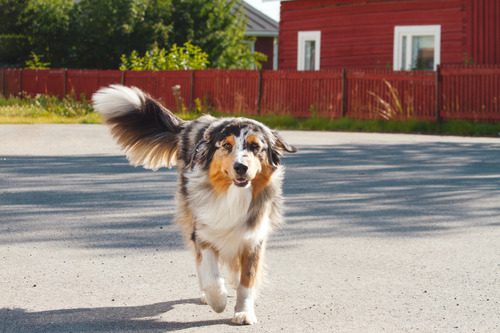What Your Dog’s Tail Wag Really Means: A Guide to Canine Communication
Dogs communicate in many ways, and one of the most expressive tools they have is their tail. Many pet owners assume that a wagging tail always indicates happiness, but canine body language is more complex. The way a dog wags its tail can reveal a wide range of emotions, from excitement and friendliness to nervousness or even aggression. Below, we’ll help you understand dog tail wag meanings to help strengthen the bond with your pet and ensure better communication between you and your canine companion.

The Science Behind Tail Wagging
Dogs use their tails as part of their natural communication system, which is deeply rooted in their evolutionary history. Unlike humans, who rely heavily on verbal communication, dogs express themselves through body language, facial expressions, and vocalizations.A dog’s tail wag is controlled by the brain’s limbic system, which regulates emotions. When a dog experiences a particular feeling, the brain sends signals to the muscles at the base of the tail, causing it to move in a specific way. Research has shown that dogs tend to wag their tails to the right when experiencing positive emotions and to the left when feeling negative or uncertain. By paying close attention to these subtle movements, pet owners can gain deeper insights into their dog’s emotional state.
Different Tail Wags and Their Meanings
Not all tail wags are the same, and the speed, position, and direction of the wag provide valuable clues about what a dog is feeling. Below are some of the most common tail wag variations and what they might mean:
The Fast, Broad Wag
A wide, fast-moving tail wag usually indicates excitement and happiness. Dogs display this type of wag when they see their favorite humans, are about to receive treats, or are engaging in playtime. This is often accompanied by other friendly body language, such as a relaxed face, wiggling body, and perky ears.
The Slow Wag with a Low Tail
When a dog moves its tail slowly while keeping it low, this can be a sign of uncertainty or submission. Dogs that are unsure about a new person or environment may display this type of wag as they assess the situation. A slow wag can also be a way of signaling that the dog does not pose a threat but is still wary.
The Stiff Wag with a Raised Tail
A stiff tail wag held high often indicates dominance or alertness. Dogs that are feeling assertive or protective may hold their tails up and wag them in small, controlled movements. If a dog exhibits this type of wag while staring intently or stiffening its body, it could be signaling a warning. Approaching a dog displaying this behavior should be done with caution.
The Low, Fast Wag
A fast wagging tail held low often means a dog is feeling nervous or submissive. This type of wag is common when a dog is unsure of a situation but is trying to appear friendly. It can also indicate a desire for reassurance from their owner or another dog.
The Tucked Tail with Wagging
If a dog tucks its tail between its legs but still wags it slightly, this typically signals fear or anxiety. Dogs that feel threatened or scared may use this gesture as a way of trying to appease a perceived threat. This is a sign that a dog needs space and comfort rather than direct engagement.
How Breed and Tail Type Influence Wagging
Not all dogs have the same tail structure, and breed differences can affect how a dog wags its tail. Some dogs have naturally short tails, like Bulldogs or Corgis, while others have long, flowing tails, like Golden Retrievers.
Dogs with Curled Tails
Breeds such as Pugs and Akitas have tails that naturally curl over their backs. Because their tails do not move as freely as straight-tailed breeds, their wagging signals may be more subtle. Owners of these breeds should pay attention to the base of the tail and overall body posture for clues about their dog’s mood.
Dogs with Docked Tails
Some breeds, like Dobermans and Boxers, have docked tails, which can make their emotions harder to read. Since these dogs rely more on body language and ear position, pet owners should observe their dog’s entire posture rather than just tail movement.
Long-Tailed Breeds
Dogs with long, expressive tails, such as Border Collies and Golden Retrievers, often have a wider range of wagging movements. Their tail positions and speeds are easier to interpret, making it simpler to read their emotions.
What Your Dog’s Tail Wag Means in Social Situations
A dog’s tail wagging behavior can change depending on the situation and the individuals they are interacting with. Here are a few examples:
Meeting New People
When a dog encounters a new person, its tail wagging behavior can reveal how it feels about the interaction. A friendly dog may wag its tail broadly and approach with a relaxed body, while a hesitant or fearful dog might wag slowly while keeping a low stance.
Interacting with Other Dogs
Dogs use their tails to communicate with each other, and tail wagging plays an essential role in social interactions. A relaxed, mid-level wag is usually a friendly greeting, while a stiff, high tail wag can indicate dominance. If a dog tucks its tail while meeting another dog, it is likely feeling submissive or anxious.
In Training or Playtime
During training sessions or playtime, a dog’s tail wag can indicate excitement and engagement. A dog that is eager to participate in training may wag its tail quickly, while a slow wag might suggest confusion. Playful wagging is often exaggerated and accompanied by bouncy movements.
Strengthening Communication with Your Dog
By paying attention to your dog’s tail wag meaning, you can better understand their emotions and respond appropriately. Here are some tips to improve communication with your pet:
- Observe overall body language: Tail wagging is just one part of a dog’s communication. Pay attention to ear position, facial expressions, and posture.
- Consider the context: The same wag may mean different things in different situations. Assess your dog’s environment before making assumptions.
- Build positive associations: Reward relaxed, friendly tail wags with treats or praise to reinforce positive interactions.
- Give space when needed: If a dog’s tail wag seems tense or hesitant, allow them time to feel comfortable before approaching.
Understanding Your Dog’s Signals Can Strengthen Your Bond
Dogs rely on their tails to express emotions, and learning how to interpret these signals enhances the bond between pet owners and their canine companions. By recognizing different tail wag meanings, you can better understand your dog’s needs and emotions in various situations. If you have concerns about your dog’s behavior or body language, schedule an appointment with Carey Animal Hospital by calling (513) 531-7117 or book an appointment online today. Our team is here to help you build a happy, healthy relationship with your pet.

